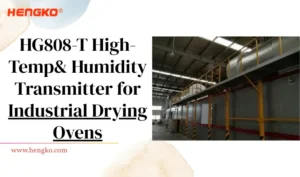
HG808-T High-Temperature Humidity Transmitter for Industrial Drying Ovens
HG808-T High-Temperature Humidity Transmitter for Industrial Drying Ovens In many manufacturing processes, drying is more
Tiny Drops, Big Impact: How Dew Point Transmitters Shape Your World
Acasă " Transmițător pentru punctul de rouă
Descoperiți factorii cheie de care trebuie să țineți cont atunci când selectați transmițătorul optim de temperatură și umiditate a punctului de rouă pentru monitorizarea fiabilă și precisă a mediului în diverse aplicații de la HENGKO.
Check Dew Point Sensor / Transmitter Selection Guide First
| Model | By Application Condition | Caracteristici principale |
| 1. Inline Dew Point Transmitter (Small HG602 Series ) | ||
Standard Precision Măsurarea punctului de rouă Dew Point Range: -60 … +60°C | - ±2 °C (±3.6℉)Td Precizie ( Punct de rouă) | |
| HG602-G (new) | Acidic / Corrosive Gas Environment Dew Point Monitoring Dew Point Range: -60 … +20°C | – ±3 °C (±5.4℉)Td Accuracy (Dew Point) – 316L stainless steel + anti-corrosion coating – Oil, salt spray & acid resistant (IP65 housing) – Suitable for HF, Cl₂, NH₃ and organic vapor applications |
Cold and Dry Environment Măsurarea punctului de rouă Dew Point Range: -30 … +50°C | - ±1℃ (±3.6℉) Td Accuracy (Dew Point) | |
| 2. Box Type Dew Point Transmitter ( HG808 Series ) | ||
| HG808-D | Normal Temperature Environment Dew Point Measurement Dew Point Range: -60 … +90°C | – Dew Point Accuracy: ±2℃ (±5.4℉) Td |
Chemical / Acidic / Solvent Gas Monitoring Dew Point Range: -60 … +20°C | – Dew Point Accuracy: ±3℃ (±5.4℉) Td | |
| HG808-A | Ultra High Temperature Moisture-Sensitive Applications + Dew Point Measurement Dew Point Range: -20 … +100°C | – Dew Point Accuracy: ±3℃ (±5.4℉) Td – Operates +80 °C to +180 °C (200 °C Short-lived) – 316L stainless steel sensor housing – Fast response & long-term stability under heat stress |
HG602 Series
Senzorul Inline Dew Point este un instrument inovator conceput pentru a se integra perfect în diverse sisteme industriale și comerciale.
HG808 Series
HENGKO oferă o gamă largă de senzori de temperatură și umiditate pentru punctul de rouă pentru multe aplicații.
HENGKO oferă o gamă largă de senzori industriali de temperatură și umiditate potriviți pentru diverse nevoi de monitorizare, de la sonde senzor din oțel inoxidabil pentru transmițătoare pentru punctul de rouă și ca următoarele 6 tipuri de soluții de dispozitive de monitorizare a temperaturii și umidității. Ne concentrăm pe furnizarea de senzori preciși, fiabili și de lungă durată, făcându-i perfecți pentru o gamă variată de aplicații.
HG970 Series
Aparatul portabil de măsurare a punctului de rouă este un dispozitiv compact, portabil, proiectat pentru măsurarea precisă și convenabilă a umidității în diverse medii.
HENGKO este un lider global în soluții de senzori industriali, cu o reputație pentru design unic și performanță excelentă. Transmițătorul și senzorul nostru de temperatură și umiditate sunt utilizate într-o gamă largă de industrii, inclusiv industria alimentară și a băuturilor, farmaceutică, de producție și de monitorizare a mediului.
Puteți personaliza complet produsul unic al senzorului de punct de rouă pe baza seriei noastre de transmițătoare de punct de rouă brevetate și concepute de noi înșine.
Veți obține un preț mult mai mic și competitiv datorită controlului nostru extrem de rentabil.
Veți satisface întotdeauna nevoile pieței în continuă schimbare cu produsele noastre în continuă modernizare.
Veți primi un suport de marketing puternic pentru a vă ajuta să vindeți produsele cu succes, suporturile materiale includ: imagini de înaltă rezoluție ale produselor, videoclipuri cool cu efect 3d și multe altele.










Senzor de punct de rouă pentru monitorizarea sistemului de aer comprimat : Asigurarea unui control optim al umidității și a calității aerului pentru mașina dvs. de comprimare a aerului
HENGKO este un producător de top de transmițătoare profesionale de punct de rouă, transmițătoare de temperatură și umiditate și contoare portabile de punct de rouă. Oferim o gamă largă de soluții de monitorizare a temperaturii și umidității pentru a vă satisface nevoile specifice.
Produsele noastre sunt concepute pentru precizie și fiabilitate, asigurând performanțe optime în diverse aplicații. Fie că aveți nevoie de un senzor de punct de rouă de înaltă calitate sau de un transmițător de umiditate robust, HENGKO are expertiza și produsele necesare pentru a vă sprijini proiectul.
Contactați-ne astăzi pentru a discuta despre cerințele dumneavoastră și pentru a descoperi cele mai bune soluții pentru nevoile dumneavoastră de monitorizare.






The dew point is the temperature to which the air must be cooled to become saturated with water vapor. In other words, it is the temperature at which the air can no longer hold any more water vapor in the form of gas. If the air is cooled further, the excess water vapor will condense into liquid water, forming dew.
The dew point is an important meteorological parameter because it is a measure of the amount of moisture in the air. The higher the dew point, the more moisture the air contains. This can make the air feel muggy or uncomfortable, especially on a hot day.
The dew point is also used to forecast the formation of fog and dew. If the dew point is close to the air temperature, then fog or dew is likely to form. This is because the air is close to becoming saturated, and any further cooling will cause the water vapor to condense.
Here is a table of general comfort levels using dew point:
| Dew Point (°F) | Comfort Level |
|---|---|
| Below 50 | Comfortable |
| 50-60 | Somewhat muggy |
| 60-65 | Muggy |
| 65-70 | Very muggy |
| Above 70 | Oppressive |
As you can see, dew point is a good indicator of how comfortable the air will feel. If you are planning to be outdoors, it is a good idea to check the dew point forecast before you go.
Here are some of the main features of dew point transmitters:
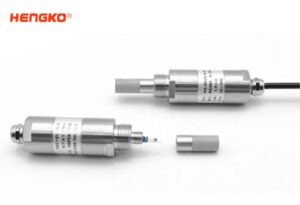
In addition to these main features, dew point transmitters may also offer a variety of other features, such as:
Dew point transmitters are a valuable tool for measuring and monitoring moisture content in a variety of applications. They are accurate, reliable, and versatile, and they can be used to improve the quality of products, protect equipment, and optimize industrial processes.
There are three main types of dew point transmitters: chilled mirror, polymer, and metal oxide.
Oglindă răcită
Chilled mirror dew point transmitters are the most accurate type of dew point transmitter. They work by cooling a mirror until water vapor condenses on its surface. The temperature of the mirror is then measured, and this temperature is the dew point. Chilled mirror dew point transmitters are typically used in applications where high accuracy is required, such as in the pharmaceutical and semiconductor industries.
Polimer
Polymer dew point transmitters are less accurate than chilled mirror dew point transmitters, but they are also less expensive. They work by measuring the change in electrical resistance of a polymer sensor as moisture content changes. Polymer dew point transmitters are typically used in applications where cost is a major concern, such as in the HVAC industry.
Oxid metalic
Metal oxide dew point transmitters are similar to polymer dew point transmitters, but they use a different type of sensor. Metal oxide dew point transmitters are typically used in applications where a wide measuring range is required, such as in the food and beverage industry.
Here is a table comparing the three main types of dew point transmitters:
| Caracteristică | Chilled Mirror | Polimer | Metal Oxide |
|---|---|---|---|
| Acuratețe | High | Medium | Medium |
| Cost | High | Low | Medium |
| Measuring Range | Wide | Narrow | Wide |
| Timp de răspuns | Slow | Fast | Medium |
| Întreținere | High | Low | Medium |
| Aplicații | Pharmaceutical, Semiconductor | HVAC | Alimente și băuturi |
The best type of dew point transmitter for a particular application will depend on the specific requirements of the application. In general, chilled mirror dew point transmitters are the best choice for applications where high accuracy is required. Polymer dew point transmitters are a good choice for applications where cost is a major concern. Metal oxide dew point transmitters are a good choice for applications where a wide measuring range is required.
Dew point transmitters are important in a variety of applications, including:
Sisteme HVAC: Dew point transmitters are used in HVAC systems to control humidity levels. Humidity is important for human comfort and health. Too much humidity can make the air feel muggy and uncomfortable, and it can also lead to the growth of mold and mildew. Too little humidity can make the air feel dry and can also lead to respiratory problems.
Controlul proceselor industriale: Dew point transmitters are used in industrial process control to ensure that products are manufactured under the correct humidity conditions. Humidity can affect the quality of many products, such as pharmaceuticals, semiconductors, and food and beverages.
Monitorizarea mediului: Dew point transmitters are used in environmental monitoring to track changes in moisture content in the atmosphere. This information can be used to forecast weather conditions and to identify potential environmental problems.
Here are some specific examples of how dew point transmitters are used in different industries:
Pharmaceutical industry: Dew point transmitters are used to control humidity levels in clean rooms where pharmaceuticals are manufactured. Humidity levels must be carefully controlled to prevent the degradation of drugs and to ensure that they are manufactured to the highest quality standards.
Semiconductor industry: Dew point transmitters are used to control humidity levels in semiconductor fabrication plants. Humidity levels must be carefully controlled to prevent the contamination of wafers and to ensure that semiconductors are manufactured to the highest quality standards.
Food and beverage industry: Dew point transmitters are used to control humidity levels in food and beverage production facilities. Humidity levels must be carefully controlled to prevent the growth of mold and mildew, to ensure that products have the correct texture, and to extend the shelf life of products.
HVAC industry: Dew point transmitters are used in HVAC systems to control humidity levels in homes, offices, and other buildings. Humidity levels must be carefully controlled to ensure human comfort and health.
Monitorizarea mediului: Dew point transmitters are used in environmental monitoring stations to track changes in moisture content in the atmosphere. This information can be used to forecast weather conditions and to identify potential environmental problems, such as drought or flooding.
As you can see, dew point transmitters are important in a wide variety of applications. They are essential for ensuring the quality of products, protecting equipment, and optimizing industrial processes.
In addition to the benefits listed above, dew point transmitters can also help to:
Choosing the right dew point transmitter for your compressed air system is crucial for maintaining efficient operation and ensuring the quality of your products. Here’s a comprehensive guide to selecting the most suitable dew point transmitter for your specific needs:
Determine the Required Accuracy: Consider the accuracy requirements of your application. If you need precise dew point measurements, a chilled mirror dew point transmitter is the most accurate option. However, if cost is a primary concern, a polymer or metal oxide dew point transmitter may be sufficient.
Evaluate the Measuring Range: Assess the dew point range you need to measure. Compressed air systems typically operate within a specific dew point range, so ensure the transmitter can cover that range effectively.
Consider Response Time and Maintenance: Response time is essential for detecting changes in dew point quickly. If real-time monitoring is critical, choose a transmitter with a fast response time. Maintenance requirements also vary between types. Chilled mirror transmitters require more maintenance, while polymer and metal oxide transmitters are generally low-maintenance.
Select the Appropriate Output Options: Decide on the output options you need for integration with your system. Common output options include analog (4-20 mA or 0-10 V), digital (RS-485 or Modbus), and alarm relays.
Environmental Considerations: Evaluate the environmental conditions where the transmitter will be installed. Choose a transmitter that can withstand the expected temperature, humidity, and vibration levels.
Caracteristici suplimentare: Consider additional features that may be beneficial, such as data logging, alarm setpoints, and remote access capabilities. These features can enhance monitoring and control capabilities.
Consult with Experts: If you have complex requirements or need assistance in selecting the most suitable dew point transmitter, consult with experienced professionals in the field. They can provide tailored recommendations based on your specific application and needs.
Here’s a summary table to aid in your selection:
| Caracteristică | Chilled Mirror | Polimer | Metal Oxide |
|---|---|---|---|
| Acuratețe | High | Medium | Medium |
| Cost | High | Low | Medium |
| Measuring Range | Wide | Narrow | Wide |
| Timp de răspuns | Slow | Fast | Medium |
| Întreținere | High | Low | Medium |
| Aplicații | Pharmaceutical, Semiconductor | HVAC | Alimente și băuturi |
| Output Options | Analog, Digital, Alarm Relays | Analog, Digital | Analog, Digital |
| Additional Features | Data Logging, Alarm Setpoints, Remote Access | Limited | Limited |
Ieșirea 4-20mA este o alegere populară pentru senzorii de punct de rouă, deoarece este o ieșire industrială standard compatibilă cu o gamă largă de sisteme de control. De asemenea, este o ieșire foarte fiabilă și rezistentă la zgomot, ceea ce o face potrivită pentru utilizarea în medii industriale dificile.
Iată câteva dintre avantajele utilizării unei ieșiri 4-20mA pentru senzorii de punct de rouă:
Compatibilitate: Ieșirea 4-20mA este compatibilă cu o gamă largă de sisteme de control, inclusiv PLC-uri, DCS-uri și sisteme SCADA. Acest lucru facilitează integrarea senzorilor de punct de rouă în sistemele de control existente.
Fiabilitate: Ieșirea 4-20mA este o ieșire foarte fiabilă, care nu este susceptibilă la interferențe de zgomot. Acest lucru este important pentru senzorii de punct de rouă, care sunt adesea utilizați în medii industriale dificile.
Acuratețe: Ieșirea 4-20mA poate furniza măsurători precise ale punctului de rouă. Acest lucru este important pentru aplicațiile în care este necesar un control precis al punctului de rouă.
Gama: Ieșirea 4-20mA poate acoperi o gamă largă de valori ale punctului de rouă. Acest lucru îl face potrivit pentru o varietate de aplicații.
Cost: Ieșirea 4-20mA este o ieșire relativ ieftină de implementat. Aceasta o face o opțiune rentabilă pentru senzorii de punct de rouă.
În plus față de avantajele enumerate mai sus, ieșirea 4-20 mA este, de asemenea, o ieșire foarte versatilă. Aceasta poate fi utilizată pentru a transmite o varietate de alți parametri, cum ar fi temperatura, presiunea și debitul. Aceasta o face o ieșire valoroasă pentru o gamă largă de aplicații industriale.
Iată câteva exemple de aplicații în care senzorii de punct de rouă cu ieșiri 4-20mA sunt utilizați în mod obișnuit:
Sisteme de aer comprimat: Senzorii punctului de rouă sunt utilizați în sistemele de aer comprimat pentru a monitoriza și controla conținutul de umiditate al aerului. Acest lucru este important pentru prevenirea coroziunii și a altor deteriorări ale echipamentelor.
Sisteme HVAC: Senzorii punctului de rouă sunt utilizați în sistemele HVAC pentru a controla nivelul de umiditate din clădiri. Acest lucru este important pentru confortul și sănătatea oamenilor.
Procese industriale de uscare: Senzorii punctului de rouă sunt utilizați în procesele industriale de uscare pentru a monitoriza și controla conținutul de umiditate al produsului care este uscat. Acest lucru este important pentru asigurarea calității produsului.
Prelucrarea alimentelor și băuturilor: Senzorii punctului de rouă sunt utilizați în procesarea alimentelor și băuturilor pentru a controla conținutul de umiditate al produsului procesat. Acest lucru este important pentru asigurarea siguranței și calității produsului.
Monitorizarea mediului: Senzorii punctului de rouă sunt utilizați în stațiile de monitorizare a mediului pentru a urmări schimbările în conținutul de umiditate din atmosferă. Aceste informații pot fi utilizate pentru a prognoza condițiile meteorologice și pentru a identifica eventualele probleme de mediu.
După cum puteți vedea, senzorii de punct de rouă cu ieșiri 4-20mA sunt un instrument valoros pentru o gamă largă de aplicații industriale. Ei sunt fiabili, preciși și versatili și pot fi integrați cu ușurință în sistemele de control existente.
Prețul transmițătoarelor pentru punctul de rouă poate varia în funcție de producător, de caracteristicile și de precizia transmițătorului. În general, transmițătoarele de punct de rouă cu o precizie mai mare și mai multe caracteristici vor costa mai mult decât transmițătoarele de punct de rouă cu o precizie mai mică și mai puține caracteristici.
Pe baza cercetărilor mele, aș spune că prețul transmițătoarelor pentru punctul de rouă este în general corect. Costul componentelor și al forței de muncă necesare pentru fabricarea transmițătoarelor de punct de rouă este ridicat, iar companiile care produc transmițătoare de punct de rouă trebuie să recupereze aceste costuri pentru a rămâne în afaceri. În plus, transmițătoarele de punct de rouă sunt utilizate într-o varietate de aplicații critice, astfel încât este important ca acestea să fie fiabile și precise. Prețul ridicat al transmițătoarelor pentru punctul de rouă reflectă faptul că acestea sunt instrumente de înaltă calitate în care se poate avea încredere pentru a furniza măsurători precise.
Iată câțiva factori care pot afecta prețul unui transmițător de punct de rouă:
Iată un tabel cu gama de prețuri a transmițătoarelor de punct de rouă de pe piață:
| Tip | Gama de prețuri |
|---|---|
| Oglindă răcită | $2,000 – $10,000 |
| Polimer | $500 – $2,000 |
| Oxid metalic | $500 – $1,500 |
După cum puteți vedea, gama de prețuri a transmițătoarelor de punct de rouă poate varia în funcție de tipul de transmițător. Transmițătoarele de punct de rouă cu oglindă răcită sunt cel mai scump tip de transmițător, dar sunt și cele mai precise. Transmițătoarele de punct de rouă cu polimeri și oxid metalic sunt mai puțin costisitoare, dar și mai puțin precise.
Prețul transmițătoarelor pentru punctul de rouă poate varia, de asemenea, în funcție de caracteristicile transmițătorului. De exemplu, emițătoarele de punct de rouă cu înregistrare a datelor, puncte de setare a alarmelor și capacități de acces de la distanță vor costa de obicei mai mult decât emițătoarele de punct de rouă cu mai puține caracteristici.
Dacă sunteți în căutarea unui transmițător de punct de rouă de înaltă calitate, v-aș recomanda să cumpărați unul de la o marcă cunoscută, care are o bună reputație în ceea ce privește calitatea și fiabilitatea. De asemenea, trebuie să luați în considerare caracteristicile care sunt importante pentru dvs. și precizia de care aveți nevoie. Dacă nu sunteți sigur ce transmițător pentru punctul de rouă este potrivit pentru dvs., vă recomand să consultați un profesionist care vă poate ajuta să luați o decizie în cunoștință de cauză.
câteva întrebări despre punctul de rouă și transmițător și senzor pe care tu și oamenii doriți să le știți
A high dew point means that the air can hold a lot of moisture before it becomes saturated and condensation occurs. In general, a dew point above 60°F (15°C) is considered high. High dew points can make the air feel humid and uncomfortable, especially on a hot day.
Actually there are two main types of dew point transmitters, each one with a different working principle, please check as following:
1. Chilled Mirror Dew Point Transmitters:
2. Polymer/Ceramic Sensor Dew Point Transmitters:
Which type is better?
The choice between a chilled mirror and a polymer/ceramic sensor transmitter depends on your specific needs:
I hope this explanation helps!
Feel free to ask or contact our Team by email if you have any further questions about dew point transmitters.
Dew point and humidity are two different measures of the amount of moisture in the air.
1.Dew point is the temperature to which the air must be cooled to become saturated with water vapor. In other words, it is the temperature at which the air can no longer hold any more water vapor in the form of gas. If the air is cooled further, the excess water vapor will condense into liquid water, forming dew.
2.Humidity, on the other hand, is the amount of water vapor in the air, expressed as a percentage of the maximum amount of water vapor that the air can hold. Relative humidity is the most common measure of humidity, and it is calculated by dividing the actual amount of water vapor in the air by the maximum amount of water vapor that the air can hold at that temperature.
There are a few different ways to calculate dew point temperature. The most common method is to use a hygrometer, which is a device that measures both temperature and humidity. The dew point temperature can then be calculated from the temperature and humidity readings using a special formula.
Another way to calculate dew point temperature is to use a psychrometer, which is a device that consists of two thermometers, one with a wet bulb and one with a dry bulb. The dew point temperature can then be calculated from the difference between the wet bulb and dry bulb temperatures using a special table or formula.
No, dew point and humidity are not the same thing. Dew point is a measure of the amount of moisture in the air, while humidity is a measure of the ratio of the amount of water vapor in the air to the maximum amount of water vapor that the air can hold.
Two different air masses can have the same dew point but different humidity levels. For example, a warm air mass with a high dew point can have the same humidity level as a cool air mass with a low dew point. This is because the warm air mass can hold more water vapor than the cool air mass.
There is no cod point in Mountain Dew. Cod points are a unit of measurement used to quantify the amount of cod liver oil in a product. Mountain Dew does not contain cod liver oil.
Intervalul confortabil al punctului de rouă pentru majoritatea oamenilor este între 40°F (4°C) și 60°F (15°C). Sub 40°F, aerul se poate simți uscat și inconfortabil. Peste 60 °F, aerul se poate simți umed și inconfortabil.
A dew point above 60°F (15°C) is considered humid. Humid air feels sticky and uncomfortable, especially on a hot day.
A dew point above 65°F (18°C) is considered muggy. Muggy air feels even more sticky and uncomfortable than humid air.
Dew point meters, also known as dew point transmitters or sensors, have a variety of purposes in different fields. Here are some of the most common ones:
1. Monitoring atmospheric conditions:
2. Controlling humidity levels:
3. Protecting equipment and materials:
4. Research and scientific applications:
Overall, dew point meters are incredibly versatile tools used across various fields to understand and manage humidity levels, ensuring safety, efficiency, and quality in diverse applications.
Testing the humidity in an air cylinder is crucial to ensure the quality and performance of the compressed air it contains. Excessive moisture can lead to corrosion, reduced flow, and malfunctioning of equipment using the air. Here are two common methods for testing humidity in an air cylinder:
1. Chilled Mirror Hygrometer:
2. Hygroscopic Sensor:
Sfaturi suplimentare:
So Above these methods and tips, you can effectively test the humidity in your air cylinder and ensure the optimal performance of your equipment.
Controlling the dew point in compressed air is crucial for ensuring the quality and performance of your pneumatic equipment. Excessive moisture can lead to corrosion, reduced flow, malfunctioning of equipment, and even contamination of sensitive products. Here are some key methods for controlling dew point in compressed air:
1. Air Dryers:
Air dryers are the most common and effective method for removing moisture from compressed air. They work by lowering the dew point, the temperature at which water vapor condenses. There are two main types of air dryers:
Refrigerant dryers: These dryers use a refrigeration system to cool the compressed air, causing water vapor to condense and drain out. They are suitable for achieving dew points down to around 40°F (4°C).
Desiccant dryers: These dryers use a desiccant material, such as silica gel or alumina, to absorb moisture from the compressed air. They can achieve much lower dew points, down to -40°F (-40°C) or even lower, making them ideal for critical applications
2. Aftercoolers:
3. Drain Traps:
4. System Design and Maintenance:
Sfaturi suplimentare:
By implementing these methods and tips, you can effectively control the dew point in your compressed air system and ensure the optimal performance and longevity of your equipment.
Dew point transmitters and sensors play a crucial role in regulating moisture levels across various industries. Here are the top 10 applications where these instruments shine:
Ensuring dry and clean compressed air is vital for efficient operation and preventing corrosion in pneumatic equipment. Dew point transmitters monitor dryness levels, optimizing dryer performance and avoiding costly issues.
Precise dew point control is critical for product quality and consistency in chemical and pharmaceutical manufacturing. Precisely measuring and managing moisture prevents reactions, ensures accurate formulations, and safeguards product stability.
Dew point control is crucial for food product quality and shelf life. Monitoring and maintaining optimal moisture levels in storage and processing environments prevents condensation, mold growth, and product spoilage.
Dew point sensors help maintain comfortable humidity levels in buildings and optimize cooling systems. Accurate dew point data allows for proper air conditioning control, maximizing energy efficiency and preventing condensation issues.
Dew point measurements are integral for weather forecasting, climate studies, and agricultural applications. Monitoring dew point variations helps predict frost, dew formation, and other environmental phenomena.
Dew point control is crucial for aircraft safety and performance. Dry air prevents ice formation on critical components, ensuring airworthiness and safe operation.
Maintaining precise dew point levels in medical facilities and biotech labs is essential for sterility and preventing the growth of harmful microorganisms.
Controlling moisture in power plants is crucial for efficient energy production and preventing corrosion in turbines and other equipment. Dew point measurement ensures optimal plant operation and minimizes maintenance costs.
Monitoring dew point during construction helps prevent condensation problems, mold growth, and structural damage. Dew point data informs proper ventilation and drying strategies, ensuring durable and healthy buildings.
Dew point sensors help optimize paint curing processes in car manufacturing and prevent condensation within sealed vehicle components. This ensures high-quality finishes and protects against corrosion.
Above are just a few examples, and transmițătoare pentru punctul de rouă and sensors have numerous applications beyond these ten.
Their versatility and precision in measuring moisture make them invaluable tools across various industries.
Do you have any specific application in mind where you’d like to know more about dew point transmitters and sensors?
Contactați HENGKO astăzi pentru orice întrebări legate de senzorul, transmițătorul și soluția pentru temperatură și umiditate

HG808-T High-Temperature Humidity Transmitter for Industrial Drying Ovens In many manufacturing processes, drying is more

Effective moisture management is essential in facilities where materials, equipment, and processes depend on controlled
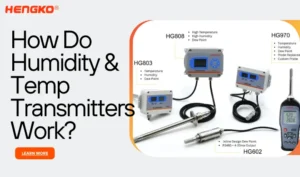
In short, Humidity and temperature transmitters measure and send environmental data to control systems. They
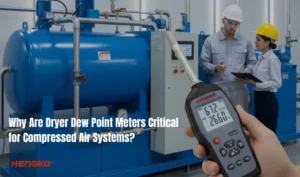
Why Are Dryer Dew Point Meters Critical for Compressed Air Systems? Maybe You always battle
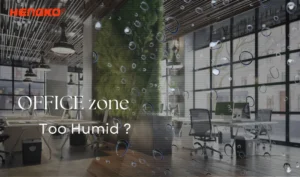
Why One Office Zone is Too Humid & How a Humidity Transmitter Fixes It Persistent
Contactați echipa noastră de experți pentru asistență personalizată și vă vom oferi prompt cele mai bune soluții de transmițătoare și senzori de temperatură și umiditate adaptate nevoilor dumneavoastră specifice.
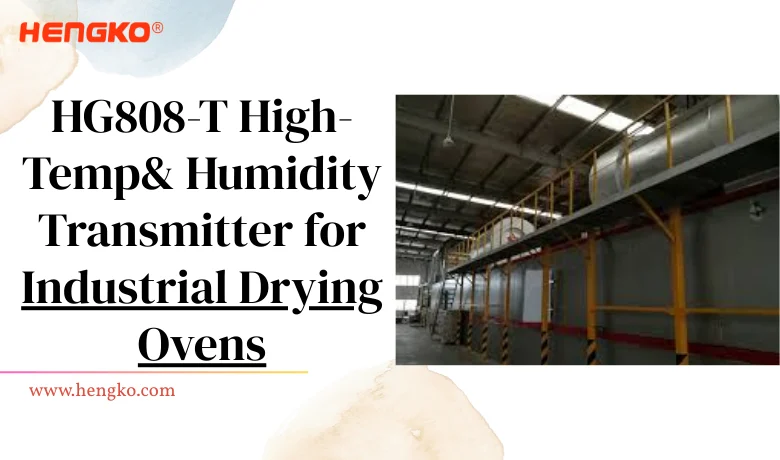
HG808-T High-Temperature Humidity Transmitter for Industrial Drying Ovens In many manufacturing processes, drying is more than just a step — it’s a decisive factor that

HG808-T High-Temperature Humidity Transmitter for Industrial Drying Ovens In many
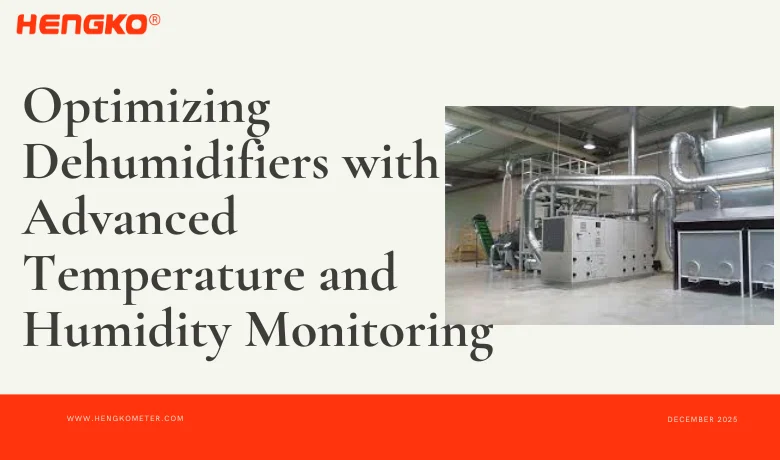
Effective moisture management is essential in facilities where materials, equipment,
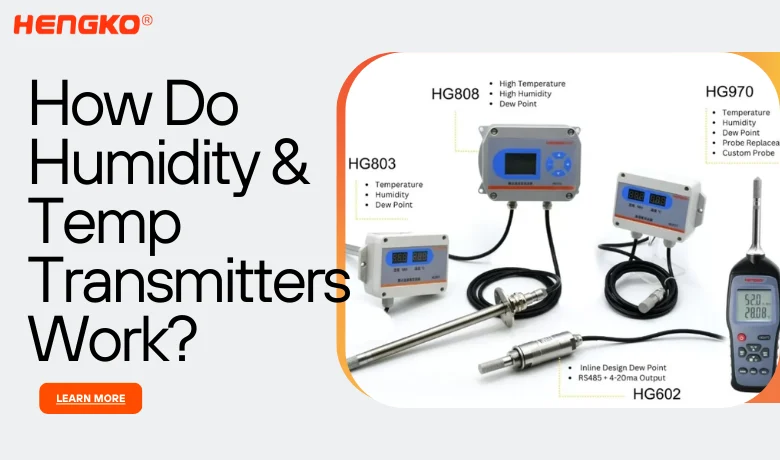
In short, Humidity and temperature transmitters measure and send environmental
WhatsApp noi